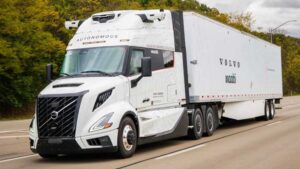NEW YORK — On Sept. 11, 2023, The North American Council for Freight Efficiency (NACFE) and Rocky Mountain Institute (RMI) launched Run on Less — Electric DEPOT (RoL—E DEPOT), an effort to understand the current state of electric trucking in North America, isolate areas that are going well and where the industry is challenged, and bring about better and faster solutions for the industry.
On Sept. 18, with nearly one-third of the data collected from the run, NACFE released some preliminary results. Data has been collected for 22 trucks operating out of 10 fleet depots.
“The data collection is going well. We used this data along with work we completed prior to the Run to identify the current state of electric trucking and areas where we can expedite improvements to the known challenges,” said Mike Roeth, executive director of NACFE.
The key points fall into six broad categories:
- Small depots are ready for electrification now, and electrification at large depots is becoming more possible.
- There have been big improvements in trucks and chargers since Run on Less — Electric in 2021.
- The industry needs cost and weight reductions to improve the total cost of ownership.
- The range can be extended with multiple charges per shift at the depot and en route.
- It’s still taking too long for power delivery and infrastructure to be installed, which is driving portable/temporary charging.
- The diversity, passion, and capability of the people involved are helping to scale the adoption of electric trucks.
“We have been able to use the data captured so far to provide a little more depth to some of these key points,” Roeth said.
Small depots in urban areas require less power, less investment and less time to complete. Here is some of that data:
- Daily Purolator and UPS delivery routes are proving to be in the 14- to 42-mile range.
- Frito-Lay completely transformed its Queens location in about one year, needing only 0.9 MWh/day of electric energy.
- Fleets charge many trucks with a few chargers, as evidenced by US Foods operating 15 heavy-duty tractors with only five portable chargers.
“The electrification of large depots is more realistic than we originally thought, and electric trucks are becoming an option in longer regional haul return-to-base operations,” Roeth said.
Here are some of the results from the data collected:
- Fleets, along with their utilities and engineering, procurement, and construction partners, are delivering big power — up to 5MWs — to these depots as well as to charge-as-a-service sites like WattEV.
- A significant amount of electricity is needed for these large, heavy-duty trucks. It is predicted that Scheider’s South El Monte depot would use 40.2 MWh/day if it were 100% electric, the highest daily energy demand we projected.
- The Tesla Semis at PepsiCo’s Sacramento beverages depot have completed 384 miles on a single charge and 806 miles on a 24-hour day, enabled by fast 750 kW charging.
- Other Class 8 tractors are demonstrating range at double that of the trucks that took part in Run on Less — Electric in 2021. There is better efficiency, including optimizing regenerative braking and return-to-base charging during single-driver shifts. This has occurred consistently at OK Produce, Penske, Performance Tea, PepsiCo, and Schneider.
“We’ve heard arguments that it is taking too long to deploy the needed infrastructure at depots and at charging-as-a-service locations,” Roeth said.
Here are some facts from the 122 interviews NACFE conducted leading up to the Run:
- It takes from 12-36 months for infrastructure implementation.
- Long planning and approval cycles are necessary to enable the grid for these large loads but are simply taking too long.
- Other issues include supply chain challenges, planning inefficiencies, delayed site permit approvals, and other problems.
- Fleets are employing temporary/portable chargers and other creative infrastructure solutions to avoid even longer delays so they can begin to use the trucks that have been delivered.
“During our 122 interviews, 49% of the people we spoke with were women and people of color. These new faces are bringing fresh energy and creative solutions to trucking and are working to overcome obstacles in order to electrify depots,” Roeth said. “These improvements in the trucks, charging, and implementation plans are critical to delivering the benefits of electric trucking that is evident in what we have learned here with RoL—E DEPOT and with past work by NACFE/RMI and others.”
The Trucker News Staff produces engaging content for not only TheTrucker.com, but also The Trucker Newspaper, which has been serving the trucking industry for more than 30 years. With a focus on drivers, the Trucker News Staff aims to provide relevant, objective content pertaining to the trucking segment of the transportation industry. The Trucker News Staff is based in Little Rock, Arkansas.














